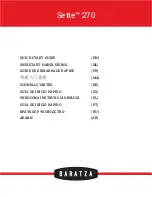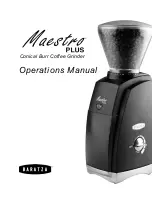
Safety Warnings Specific for Grinding and Abrasive Cutting-Off Operations
Operations
a) Use only wheel types that are recommended for your power tool and the
specific guard designed for the selected wheel.
Wheels for which the power tool
was not designed cannot be adequately guarded and are unsafe.
b) The guard must be securely attached to the power tool and positioned for
maximum safety, so the least amount of wheel is exposed towards the
operator.
The guard helps to protect operator from broken wheel fragments and
accidental contact with wheel.
c) Wheels must be used only for recommended applications. For example: do
not grind with the side of cut-off wheel.
Abrasive cut-off wheels are intended for
peripheral grinding, side forces applied to these wheels may cause them to shatter.
d) Always use undamaged wheel flanges that are of correct size and shape for
your selected wheel.
Proper wheel flanges support the wheel thus reducing the
possibility of wheel breakage. Flanges for cut-off wheels may be different from
grinding wheel flanges.
e) Do not use worn down wheels from larger power tools.
Wheel intended for
larger power tool is not suitable for the higher speed of a smaller tool and may burst.
Additional Safety Warnings Specific for Abrasive Cutting-Off Operation
a) Do not “jam” the cut-off wheel or apply excessive pressure. Do not attempt to
make an excessive depth of cut.
Overstressing the wheel increases the loading
and susceptibility to twisting or binding of the wheel in the cut and the possibility of
kickback or wheel breakage.
b) Do not position your body in line with and behind the rotating wheel.
When
the wheel, at the point of operation, is moving away from your body, the possible
kickback may propel the spinning wheel and the power tool directly at you.
c) When wheel is binding or when interrupting a cut for any reason, switch off
the power tool and hold the power tool motionless until the wheel comes to a
complete stop. Never attempt to remove the cut-off wheel from the cut while
the wheel is in motion otherwise kickback may occur.
Investigate and take
corrective action to eliminate the cause of wheel binding.
d) Do not restart the cutting operation in the workpiece. Let the wheel reach full
speed and carefully reenter the cut.
The wheel may bind, walk up or kickback if
the power tool is restarted in the workpiece.
e) Support panels or any oversized workpiece to minimize the risk of wheel
pinching and kickback.
Large workpieces tend to sag under their own weight.
Supports must be placed under the workpiece near the line of cut and near the
edge of the workpiece on both sides of the wheel.
f) Use extra caution when making a “pocket cut” into existing walls or other
blind areas.
The protruding wheel may cut gas or water pipes, electrical wiring or
objects that can cause kickback.
Safety Warnings Specific for Sanding Operations
a) Do not use excessively oversized sanding disc paper. Follow manufacturers
recommendations, when selecting sanding paper.
Larger sanding paper
extending beyond the sanding pad presents a laceration hazard and may cause
snagging, tearing of the disc or kickback.
Safety Warnings Specific for Polishing Operations
a) Do not allow any loose portion of the polishing bonnet or its attachment
strings to spin freely. Tuck away or trim any loose attachment strings.
Loose
and spinning attachment strings can entangle your fingers or snag on the
workpiece.
Safety Warnings Specific for Wire Brushing Operations
a) Be aware that wire bristles are thrown by the brush even during ordinary
operation. Do not overstress the wires by applying excessive load to the
brush.
The wire bristles can easily penetrate light clothing and/or skin.
b) If the use of a guard is recommended for wire brushing, do not allow any
interference of the wire wheel or brush with the guard.
Wire wheel or brush
may expand in diameter due to work and centrifugal forces.
Additional Safety Information
•
Do not use Type 1 flat cut-off abrasive or diamond wheels without proper guard. (Guard
not included with unit.)
WARNING: ALWAYS
use safety glasses. Everyday eyeglasses are NOT safety glasses.
Also use face or dust mask if cutting operation is dusty. ALWAYS WEAR CERTIFIED
SAFETY EQUIPMENT:
• ANSI Z87.1 eye protection (CAN/CSA Z94.3),
• ANSI S12.6 (S3.19) hearing protection,
• NIOSH/OSHA/MSHA respiratory protection.
WARNING: Some dust created by power sanding, sawing, grinding, drilling, and
other construction activities contains chemicals known to the State of California to
cause cancer, birth defects or other reproductive harm.
Some examples of these
chemicals are:
• lead from lead-based paints,
• crystalline silica from bricks and cement and other masonry products, and
• arsenic and chromium from chemically-treated lumber.
Your risk from these exposures varies, depending on how often you do this type of work.
To reduce your exposure to these chemicals: work in a well ventilated area, and work with
approved safety equipment, such as those dust masks that are specially designed to filter
out microscopic particles.
• Avoid prolonged contact with dust from power sanding, sawing, grinding, drilling,
and other construction activities. Wear protective clothing and wash exposed
areas with soap and water.
Allowing dust to get into your mouth, eyes, or lay on the skin
may promote absorption of harmful chemicals.
WARNING:
Use of this tool can generate and/or disburse dust, which may cause serious
and permanent respiratory or other injury. Always use NIOSH/OSHA approved respiratory
protection appropriate for the dust exposure. Direct particles away from face and body.
WARNING: Always wear proper personal hearing protection that conforms to ANSI
S12.6 (S3.19) during use.
Under some conditions and duration of use, noise from this
product may contribute to hearing loss.
WARNING: Always use eye protection.
All users and bystanders must wear eye
protection that conforms to ANSI Z87.1.
WARNING: When not in use, place grinder on a stable surface where it will not
move inadvertantly, roll or cause a tripping or falling hazard.
The grinder may stand
upright on the battery pack but may be easily knocked over. Serious personal injury may
result.
CAUTION: To reduce the risk of personal injury,
use extra care when working into a
corner or edge because a sudden, sharp movement of the tool may be experienced when
the wheel or other accessory contacts a secondary surface or a surface edge.
The label on your tool may include the following symbols.
V ..........................volts
A..........................amperes
Hz ........................hertz
W ........................watts
min ........................minutes
......................alternating current
......................direct current
no ........................no load speed
..........................Class II Construction
........................
earthing terminal
........................safety alert symbol
SPM ....................strokes per
.../min ....................revolutions or
minute
reciprocations per minute
Extension Cord
When using an extension cord, be sure to use one heavy enough to carry the current your
product will draw. An undersized cord will cause a drop in line voltage resulting in loss of
power and overheating. The table below shows the correct size to use depending on cord
length and nameplate ampere rating. If in doubt, use the next heavier gage. The smaller
the gage number, the heavier the cord.
Motor
Your tool is powered by a Black & Decker specified motor. Be sure your power supply
agrees with the nameplate marking. A marking of 120 volts, 50/60 Hz or 120 volts, AC only
means that the tool is designed to operate on normal 120 volt house current. Voltage
decrease of more that 10% will cause loss of power and overheating. All Black & Decker
tools are factory tested. If this tool does not run, check the power supply.
ASSEMBLY
WARNING: To prevent accidental operation, turn off and unplug tool before
performing the following operations.
Failure to do this could result in serious
personal injury.
Attaching the Wheel Guard - Fig. 2
WARNING:
NEVER GRIND OR BRUSH WITHOUT GUARD IN PLACE.
• Place the tool on a table, with the spindle (9) facing up.
• Place the spring washer (8) over the spindle and locate it on the shoulder (10).
• Place the guard (4) onto the tool as shown.
• Place the flange (7) over the spindle with the protruding pips towards the guard. Make
sure that the holes in the flange align with the screw holes.
• Secure the flange with the screws (6). Make sure that the screws are fully tight and that
the guard can be rotated.
Removing the Wheel Guard (For Sanding Only) - Fig. 3
CAUTION:
To prevent loss of control, do not set tool down until accessory has
completely stopped turning.
This tool is fitted with a guard. For sanding only, you can remove the guard as follows:
• Remove the outer flange, disc and inner flange if they have been attached.
• Use a screwdriver to remove the screws (6).
• Remove the flange (7), guard (4) and spring washer (8). Store these parts carefully.
1. On/off switch
Interrupteur Marche/Arrêt
Conmutador de encendido y apagado
2. Lock-on button
Bouton de verrouillage en position de marche
Botón de bloqueo en encendido
3. Side handle
Poignée latérale
Mango lateral
4. Spindle lock
Bouton de verrouillage de la broche
Seguro del eje
5. Guard
Dispositif de protection
Protector
6
6
7
8
4
14
12
13
11
7
14
12
11
7
14
12
11
7
A
B
14
15
5
12
3
5
6
7
6
6
7
4
9
8
10
2
1
4
Minimum Gage for Cord Sets
Volts
Total Length of Cord in Feet
120V
0-25
26-50
51-100
101-150
(0-7,6m)
(7,6-15,2m) (15,2-30,4m) (30,4-45,7m)
240V
0-50
51-100
101-200
201-300
(0-15,2m) (15,2-30,4m) (30,4-60,9m) (60,9-91,4m)
Ampere Rating
More
Not more
American Wire Gage
Than
Than
0
-
6
18
16
16
14
6
-
10
18
16
14
12
10
-
12
16
16
14
12
12
-
16
14
12
Not Recommended
10
11
9
7A
8



























